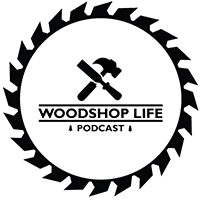Support us on Patreon: https://www.patreon.com/woodshoplife
Sean
1) Hey Guy,Huy,& Sean. I just picked up a pair of Mitutoyo calipers. I use a straight edge and feeler gauges to set up machines like my jointer. Do you guys use precise tools like calipers,feeler gauges, and straight edges. when your building furniture, it seems like they could be really useful. All 3 of you have that engineering type of brain. (Huy being an actual engineer). If you do use them in your furniture. What do you use them for? Or are tools like calipers overkill for woodworking. Cheers, Nate
2) When you bring a new tool into the shop do you find yourself using that tool as an excuse to rearrange your shop, even if it’s an upgrade from a tool you already have?
I’ve found myself rearranging my entire workflow every time I introduce a new tool even if the one I’m upgrading one that’s been in a certain spot for years.
I hope all has been well with you and your families. Please continue with the fantastic content! Thank you for your time. Brent Jarvis Clean Cut Woodworking
Huy
1) Hey my name is Mike from odd materials woodworks I have been really enjoying your podcast.
I have been following all three of you for a while.
Anyways in listening to some of your past podcasts you have discussed the mft with the flip up arm and how you don’t use it anymore.You just use a set of dog with the rail clip which I have been thinking of switching to. My question is how would you approach making repeatable cuts on an MFT style table? Thanks again Mike
2)What is your method for fixing drift when re-sawing with a fence on your bandsaw? Michael
Guy
1)Hi Guys, love the show and the chemistry between you guys, I’m fairly new in the woodworking world with previous experience as a finisher, now I moved to making my own furniture line. I have three questions for you guys:
1- Any tips for crosscutting plywood?
2- How do you guys keep the shop organized with the leftovers of material?
3- If budget weren’t an issue what would you buy first a Festool Track Saw or a Sawstop Cabinet Saw?? (I mostly work with sheets of plywood) Thank you and keep up the good work, Karel
2) Hope this is a quick one for ya – I’m stumped on something and it’s making me crazy. I’m making cutting boards, I’ve got about 10 under my belt at this point. Most of my quality priorities are improving nicely with time and experience but I have a problem with finishing; specifically grain that raises on my finished product shortly after the board gets put into use.
For context I’m talking about edge grain boards. I get a great glue-up, scrape them down, finish plane, then onto sanding. I take it to 180 all around, then I raise the grain. I take that down with 220, then I raise it again. I really thought that raising the grain twice, incrementally, would give me an extra level of redundancy against surface issues moving forward. I finish with 320, then go with a generous treatment of mineral oil followed by the 4-1 oil/beeswax routine.
The “fuzziness” isn’t across the entire board, but there’s enough of it there to both mystify and frustrate me. I really put a lot of work into these and I’m trying to get the highest quality that I can achieve. Everyone expects a board to need care, but my gut says that sandpaper shouldn’t be involved.
What am I overlooking here? Any assistance will be greatly appreciated; love the show, keep up the great work. collin
